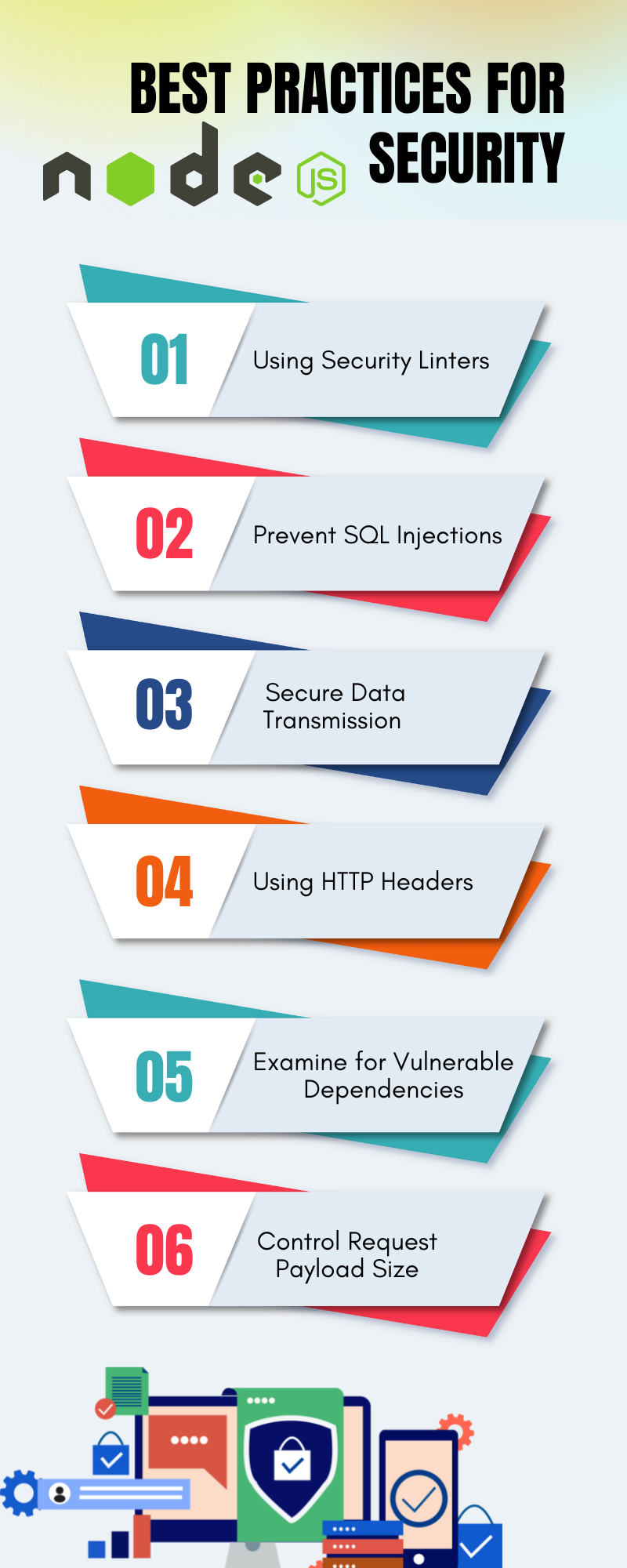Over the past few years, the software and application development game has taken businesses to reach new heights and has served well to both businesses and their consumers. And to develop powerful and robust applications there are numerous technologies, languages, and frameworks available in the market, and Node.js is among them.
It is the second most preferred framework by developers and Node.js development companies, used in the development of applications, and many renowned corporations use this in their applications.
But do not forget Node.js has many security issues that come along with it and not to worry these Node.js security issues also come with certain practices to get control of all the security vulnerabilities.
Read: Why Choose NodeJS For IoT Applications?
Before moving ahead, with the best practices for Node.js security let us fill you up with the basic overview of Node.js along with its advantages and disadvantages.
So, let's get started with it.
Overview of Node.js
Node.js or NodeJS is a widely preferred framework for web development. It is an open-source, cross-platform, asynchronous, and event-driven runtime environment of Javascript used for both frontend and backend development.
It is based on Google’s V8 engine and is written in C, C++, and Javascript. Additionally, NodeJS is faster, scalable, and reliable, and also has a vast ecosystem of Javascript libraries. Netflix, PayPal, IBM, and eBay, are some of the well-known companies that use Node.js in their applications.
Read:Top 10 reasons why you should learn Node.JS
Advantages that will help you decide why to choose Node.js-
-
It is easy to start with even if you are a beginner with Node.js, and its event-driven architecture makes it scalable.
-
Comes with a powerful tech stack, enabling the developers to gain access to Javascript resources.
-
Additionally, it has a large community of developers and global contributors who help you with solutions, in case you get stuck anywhere in the project.
-
Node.js comes with NPM (Node Package Manager) which is used in the development of web applications.
-
Another advantage of Node.js is that it streamlines the speed of transmitting data into multiple streams which in turn will improve the quality of the application.
Now that you have a basic idea of what Node.js is and the advantages that come with it, you should also know the disadvantages of the same.
The cons of using Node.js are -
-
It lacks a library support system which is a threat to the code, and also makes it difficult for the developers sometimes while developing high-end and large-scale applications.
-
Node.js has an unstable API, which calls for a lot of code changes.
-
It also reduces the performance of the application, when handling heavy computing tasks.
Read: Best Practices for API Security
The above-mentioned were some of the important drawbacks of using Node.js which can be left behind and mastered with advancements in technology in the future.
What are the best practices to improve Node.js security?
Now moving ahead, when we talk about developing software, security has been a primary concern for everyone nowadays.
Read: Top Node JS Frameworks for Web Application Development
But when we specifically talk about Node.js, the projects have security issues. Below we have listed a few of the practices to improve Node.js Security, to help you develop and deliver a more efficient and secure application.
-
Using Security Linters
-
Prevent SQL Injections
-
Secure Transmission of Data
-
Using HTTP Headers
-
Examine for Vulnerable Dependencies
-
Control Request Payload Size
Using Security Linters
Security linters help you to review the code source code automatically, identify faults, and security vulnerabilities and alert the developer about the issues, and unsafe code practices before the code is compiled.
Additionally, these linters have their own set of rules which are customizable according to your requirements, so before getting started with the process make sure that you configure the rules that detect the security vulnerability. ESLint, JSHint, and TSLint are some examples of JS linting tools that are used within Node.js.
Security linters make it easier to audit your systems and submit accurate security reports, such as an ISO 27001 report. Having ISO 27001 compliance is essential in certain industries, but even when it isn’t, having that high level of security benefits you and your customers.
Prevent SQL Injections
It is a common reason for most security attacks, where the attacker uses malicious SQL code to manipulate the database and gain access to sensitive information. The frequent use of JS strings or string concatenations increases the risk of database manipulation, which also increases the risk of invalidated information making the application vulnerable to SQL injection attacks.
To avoid these attacks you can primarily validate the values provided by the user. For example - the contact number field is found in almost every software, so the input provided from the front end should be accepted only when they fulfill a specific format with numbers and special characters. Additionally, you can also use the in-built database and generic libraries like Mongoose and Sequelize respectively.
Secure Transmission of Data
Data is an integral part of every software and keeping it secure and confidential is very important, but is also a major reason that compromises the security of an application. And to establish a secure connection you can use protocols like TLS (Transport Layer Security) and SSL (Secure Sockets Layer). Also, you can use encryption techniques and also keep track of network security and configure the system with strict security layers.
Read: Common SSL/TLS errors: how to find and fix them
Using HTTP Headers
To prevent clickjacking and other malicious attacks, you can use secure HTTP Headers in your Node.js applications. A plugin like Helmet is easy to configure and it also follows the best practices to secure the headers for boosting the security in Node.js applications.
Read: Best Tech Stack for Web App Development
The HTTP headers can be used in different ways, which include the HTTP Strict Transport Security response header to establish a secure HTTPS connection with the application, and also protects from cookie high jacking and protocol downgrade, X-Frame-Options to prevent attacks by displaying content within the frames, X-Content-Type-Options, and many more.

Examine for Vulnerable Dependencies
The NodeJS ecosystem consists of numerous modules and libraries, and it's common that most of them will be used during the development, ending up with many dependencies in just one project. And when the code is written by someone else it also creates a security issue, enabling multiple entry points for attackers to exploit.
Read: Best Practices for Unit Testing in Java
The solution to this is to run frequent vulnerability scans to help you find all the dependencies, and you can also use tools like NPM audit, Snyk, and many more.
Control Request Payload Size
The payload size is another thing that exposes the application to security threats. When the traffic on an application increases sometimes it gets difficult to manage them, which in turn consumes more processing power and also lowers the app’s performance, and makes it vulnerable to DOS (Denial-Of-Service) attacks.
So it is important to limit the payload size by using an express body parser, allowing you to limit the incoming requests and accept those that come under the predefined parameters.
Read: Cybersecurity Trends
Summing Up
The popularity of Node.js is expected to grow even more in the future, and companies are rapidly adopting this framework to build applications and leverage the benefits.
Securing and safeguarding the data and the application is very important and security measures should be executed properly whenever required.
And with the implementation of the practices mentioned above, you can develop high-performing applications that are safe from attacks, for your clients or your business.
Additionally, implementing these practices into your Node.js application will also help you in minimizing Javascript run-time errors and help you develop a secure and robust Node.js application.




